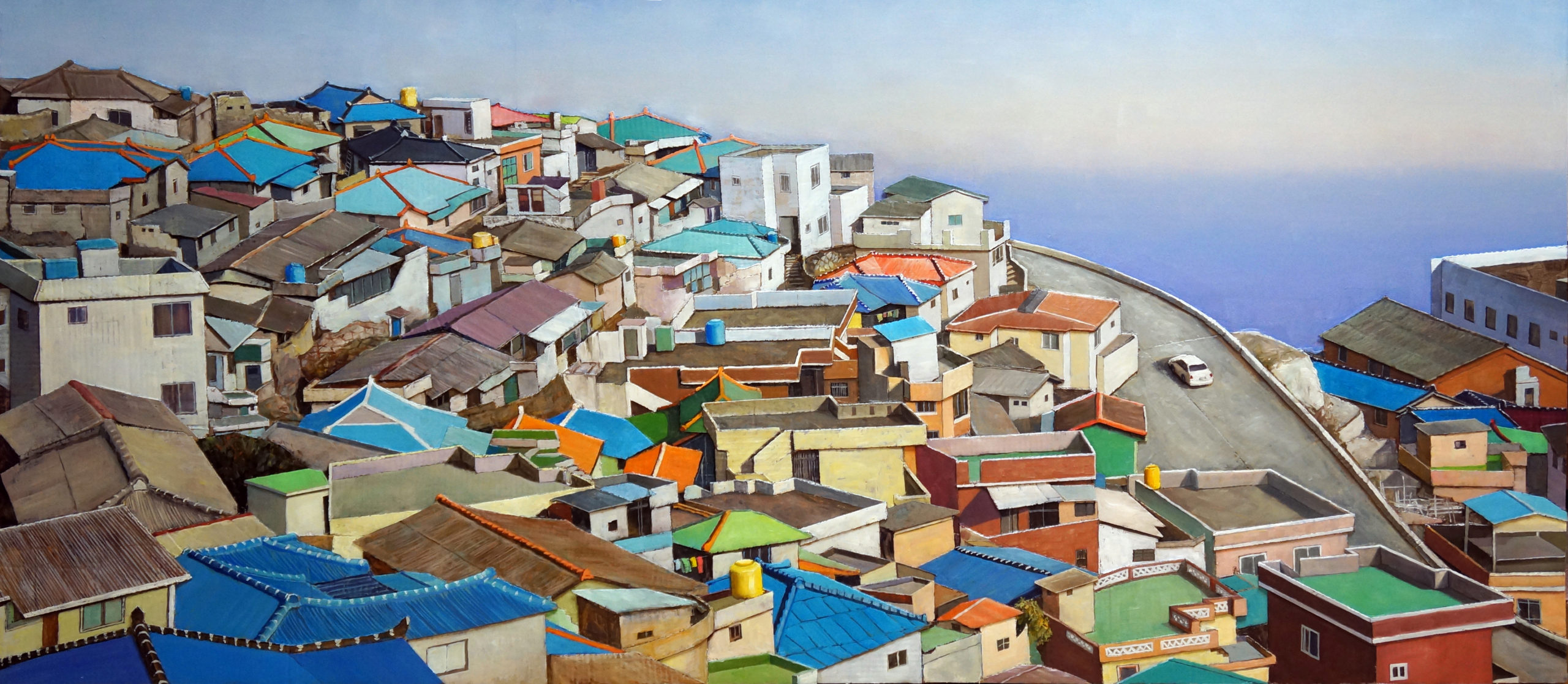Two Peas in Their Pods: Yang Na-hee and Noh Yeo-woon
By Kang Jennis Hyun-suk.
Some artists attempt to express their inner selves on canvas, others undertake to foretell the future, still others paint the present, and then there are those who take it as their mission to preserve the past. This month Kang Jennis Hyunsuk introduces two young-ish artists who bring back vivid memories of their childhood through the dwellings of the era – an era where the single-story, tile-roofed house had given way to the two-story, concrete icheung-jip
(이층집) that populated the alleyways of our fair city, and when the present-day, ubiquitous apartment complex was still nowhere to be found in Gwangju. These two artists both take as subject matter the dwellings of the alleyways and byways of the past, but as Kang discovers, they are not two peas in the same pod – no two artists are – but these two artists’ pods spring from the same pea plant. — Ed.
This article features two young artists who depict the old houses, alleys, and neighborhoods of Gwangju. They capture that which is being left out and forgotten in this fast-paced world. These two Gwangju artists are Yang Na-hee and Noh Yeo-woon.
A major commonality of these two artists is that they constantly strive to find the essence of life through the observation of human beings and surrounding phenomena. Yang Na-hee’s and Noh Yeo-woon’s works seemed similar to me at first, but as I learned more about each artist, I discovered that each has their own unique style of painting.

Artist Yang Na-hee
Yang Na-hee’s work is three-dimensional. She cuts up cardboard boxes to make houses and villages, and on top of this, she colors them with oil paints. In Korea, neighborhoods of houses on urban hilltops are called “moonrise villages” (dal-dongne, 달동네), which means that the moon rises from behind the houses on the hilltop. The small houses are attached side by side in a maze of alleys. The moonrise villages on hills were usually those of people who moved to the city from the countryside when the nation was in the process of changing from an agricultural economy to an industrial one. Most of the residents were financially disadvantaged. Now, many of these hillside villages have been torn down in the name of redevelopment. The artist Yang Na-hee describes the disappearing hillside villages with corrugated cardboard.
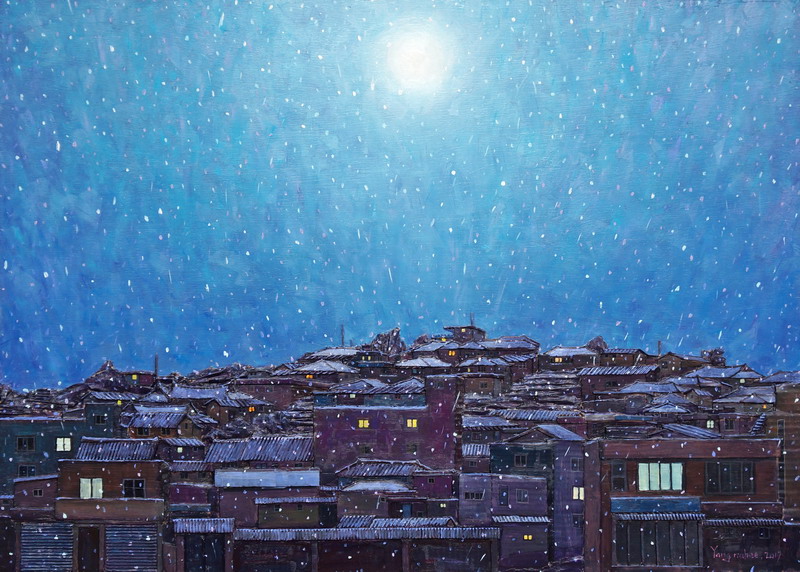
Interview with Yang Na-hee
Jennis: I am curious, Ms. Yang, as to what led you to decide to create your works out of corrugated cardboard.
Yang Na-hee: It was when I was around the age of 30 – several years after I graduated from studying art in college and had started working as an artist. But it was a time of obscurity, when no one recognized me or my works. I was nervous and at a loss as to what to do or how to live, and I was not sure how long I could paint. One day, as I was struggling with the canvas and embracing my loneliness and anxiety as usual, I noticed corrugated boxes piled up in a corner of the house. Since I spent most of my time in the studio, I usually ordered items on the internet and got the necessary items delivered. So, the boxes began to pile up. The empty boxes awaiting disposal reminded me of the old people who collected empty boxes and sold them for their livelihood. It was the winter of 2011 when I saw an old woman in her 80s picking up discarded boxes. I felt sympathetic and thought about how useless things for one person could be a means of survival for others. I came to contemplate how we define things between usefulness and uselessness. I wanted to find new value in the things that are usually thought of as worthless. It was like finding new value in myself by taking on this new project of creating art from cardboard.

Jennis: You discovered a new material, corrugated cardboard, and depicted the “moonrise village” through it. Did you also choose the topic for the same reason as the material?
Yang Na-hee: Yes. One day, I was walking in an area that was hollow and empty, having been made ready for redevelopment. I could see the empty carts and empty houses. Only a few old people who had not moved yet were basking in the warmth of the sun. I felt that they were on an isolated island though they were living in the same city as me. I went back home and used discarded cardboard to capture the warm, sunny houses while thinking of the “islanders.” I wanted to make it possible for us to remember our surroundings that are being abandoned and forgotten.
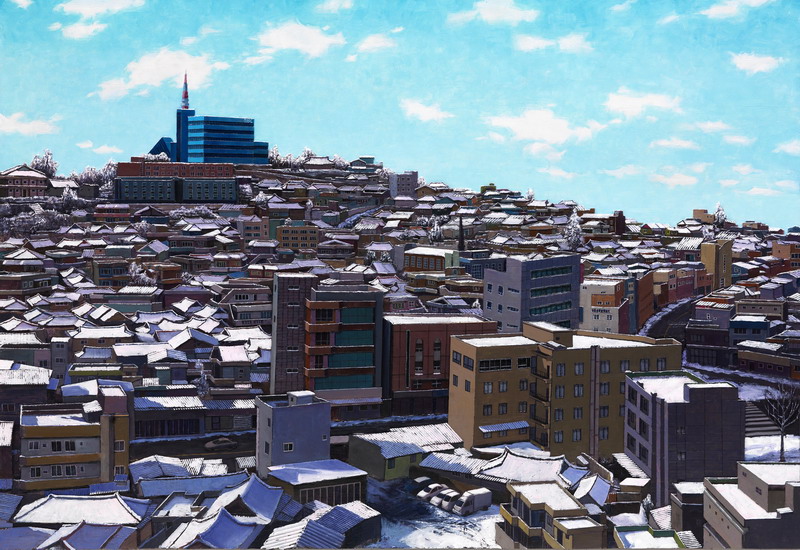
Jennis: One of your works is called “Sunrise Village” (Hae-dongne). How did you come to name it “Sunrise Village,” rather than the commonly used expression “moonrise village” (Dal-dongne)?
Yang Na-hee: “Sunrise village” is the other side of “moonrise village.” It also has stars at night and sunlight in the morning. The work “Sunrise Village” expresses the place where night, dawn, and the morning scenery coexist. I tried to convey hope as the bright sunlight spreads out, as if it moves from the darkness of the past to the brightness of the future.
Jennis: Looking at your recent works, there are countless stars in the night sky. What is the story behind “Song of Starlight”?
Yang Na-hee: The farther away one gets from the twinkling city of neon signs, the closer we can get to the stars. There needs to be silence and darkness to get close to the stars. When I see countless stars in the night sky, I can feel the depth of space. I wanted to express cosmic emotion with stars pouring down on trees and waves.
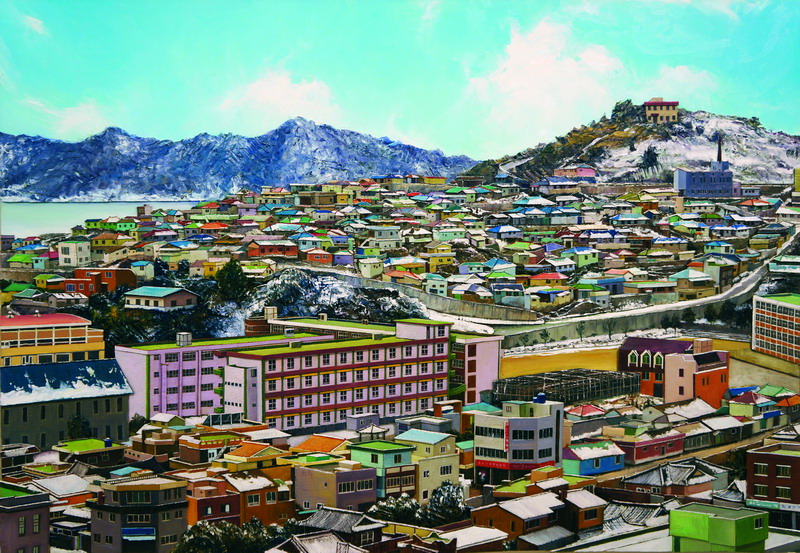
Jennis: The work is really just like its title: “Song of Starlight.” I also want to ask if you have any plans for future artwork?
Yang Na-hee: I still want to find further value and meaning in things. I hope many people who see my works will also be able to find value and meaning in them.
Jennis: I for one have found great value and meaning in your art and through this interview. Thank you.
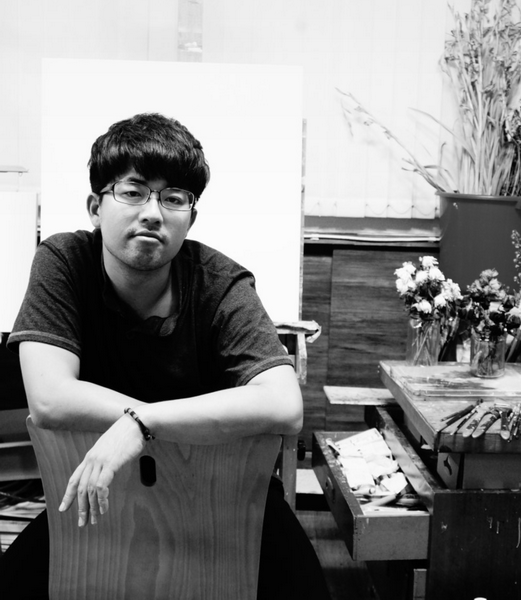
Artist Noh Yeo-woon
A sense of nostalgia exudes from the alleyway. In the narrow alleyways of my old neighborhood, the houses were so close that I could even tell what my neighbors were having for dinner. The children ran around the alleys together, and the elderly watched the alley cats from their chairs. The narrow alley was a community of urban people who could not forsake the memories of their rural communities after moving to the city. As the world rapidly changes, people spend less time sitting in alleyways with their neighbors, and the busy world craves for a much faster way of life. So, back alleyways too narrow for cars to enter, and blind alleys as well, began to be shunned, and newly built high-rise apartments started to become a symbol of wealth. Migration from the alleyways to apartment complexes is still on the rise. Along with the disappearance of alleyway neighborhoods is the disappearance of the culture of the alleyway. People who were born after the 1990s are mostly apartment dwellers who have no idea what the sentiment of the alleyway is.
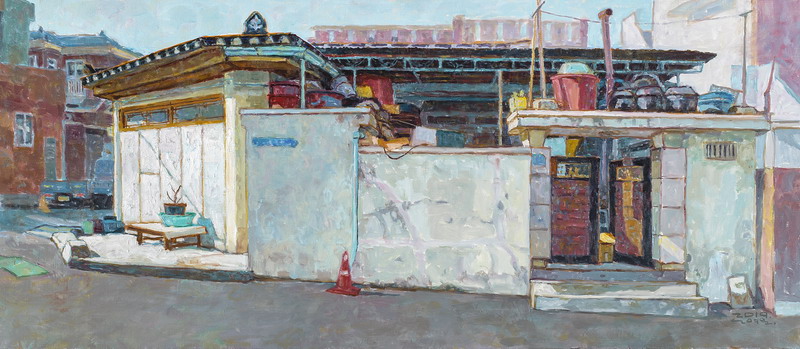
The moment I saw Noh Yeo-woon’s alleys at an art fair, I was reminded of my childhood. I thought the artist was probably an older person with long-held memories of the old alleys. Contrary to my expectation, he is a young artist, and his studio is in an alley, just like those depicted in his artwork. I was able to see the process of his artwork in his studio. Rough sketches and new paintings were hanging on all the studio walls as we began our interview.
Interview with Noh Yeo-woon
Jennis: I can feel a sense of nostalgia for the old days when I look at your artwork, and I am surprised once again that you are as young as you are. How did you come to draw scenes of our residential alleyways?
Noh Yeo-woon: Before I entered elementary school in Hak-dong here in Gwangju, I lived in Haenam and Yeongam. I missed the rural life after moving to the city. Luckily, there was an eight-way intersection in Hak-dong with a neighborhood tree at the center of the eight alleyways. In the summertime, adults sat under the shade of the tree fanning themselves, and children played hide-and-seek in the maze-like alleys. When I was an art student in college, I heard the news that this alley-rich neighborhood would be torn down in the name of redevelopment. So, I wanted to keep the memories of this place alive in paintings.
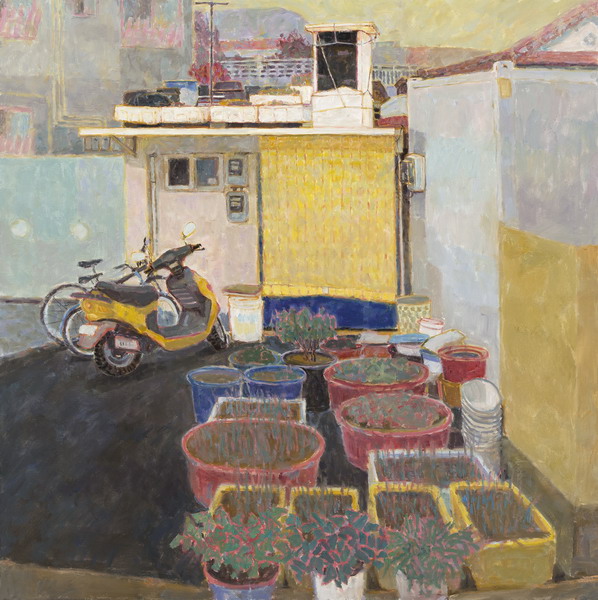
Jennis: There are no people in your paintings, but in their absence, I can sense a human presence. Through your paintings, we can get a glimpse of the lives of people from a house’s furnishings seen through its translucent window, or from an old stroller that an old lady used to carry her gleanings from the throwaways of others. I feel the warmth of life whose presence was there just a minute before.
Noh Yeo-woon: That is right – people do not appear in my paintings. But I wanted to talk about people’s memories and their past through old gates, fences, and rooftops. There are flowerpots in the old alleyways. Sometimes a bathtub becomes a vegetable garden. I imagine the lives of individuals by looking at such traces.
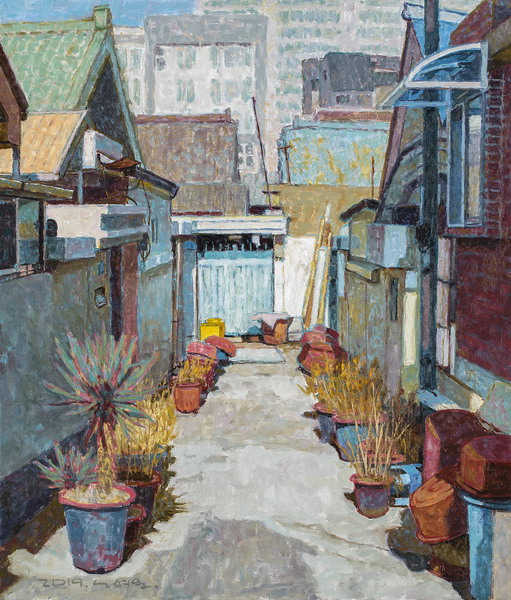
Jennis: Potted plants are said to be the smallest garden in the world. The people of the alleyways must have felt spring, summer, autumn, and winter through those many small gardens. I have heard that Seoul has an alley tour for people who miss these disappearing neighborhoods. Do you have any plans to work on alleyways in other cities?
Noh Yeo-woon: I will continue to work on backstreets and alleyways until I find another interesting theme. The alleys I paint express the feelings I have after having observed them for a long time, visiting them both in the daytime and at night. So, it takes a lot of time for me to do a single painting. However, I would like to study the alleyways in other cities someday.
Jennis: I would like to know how you go about making the colors that appear in your paintings. You seem to have your own unique colors. What is the secret?
Noh Yeo-woon: I usually use nine to twelve colors and mix them in various ways to express my feelings. Going out to paint landscapes with my “seniors” was very helpful for me when I was studying art in college. Some people say my landscapes look like still lifes. Actually, my personality is quite static, so I like to use simplified colors.
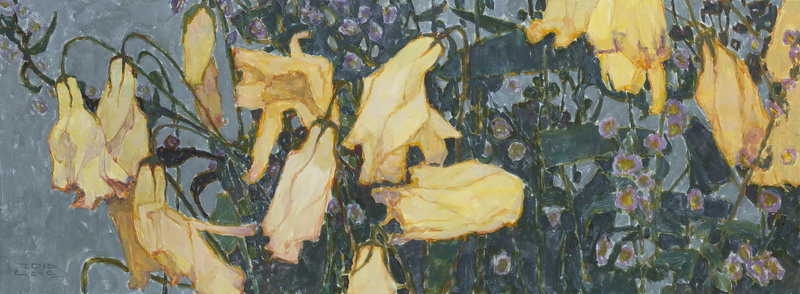
Jennis: I have also seen your series on wilted flowers, “It’s Enough Just to Have Bloomed.” Can I ask what you want to express through these withered flowers?
Noh Yeo-woon: I have come to think that young people my age are like withered flowers. I got a bunch of flowers from a friend at an exhibition, and I put them into a vase. A few days later, when I saw the wilted flowers, I felt they were like my friends and myself: We are grown to be beautiful flowers and strive to become good products in this society of capitalism. But just as getting a job should not be our end goal in life, we should not be commercialized like flowers for sale.
Jennis: The descriptions of your paintings confirm for me that you are a very thoughtful artist. What do you most want people to feel when viewing your paintings?
Noh Yeo-woon: It would be nice if people felt a sense of warmth and comfort through my paintings.
Jennis: Oh, I can confirm that your paintings do create a feeling of warmth and comfort – and a very nostalgic one for me. Thank you.
Artworks courtesy of Yang Na-hee and Noh Yeo-woon.
THE AUTHORS’ PROFILES
Yang Na-hee
— Exhibitions: 10 Individual, 150 Group.
— Awards: Gwangju Art Award (2020); Gwangju Art Award, Special Award (2019); Namdo Cultural Foundation Young Artist Contest, Selection Award (2018); Korea Art Exhibition, Outstanding Award (2016).
— Collections: National Museum of Contemporary Art (Art Bank), Government Art Bank, Gwangju Museum of Art, Namdo Art Bank.
Noh Yeo-woon
— Exhibitions: Remember: Sansu, Sansu Museum of Art (2019); It’s Enough Just to Have Bloomed, Gallery Riche (2016); Rest, Taking a Break for a While, Gwangju Shinsegae Gallery (2016); Flows, Lotus Gallery (2014); Falling in Winter, Lotte Gallery (2019); Young Artists’ Exhibition, DeYoung Art Museum (2018); Between Eye Deception and Metaphor, Mokdam Art Museum (2017); AsiaF, Dongdaemun Design Plaza (2017); Time + Relationship = Us, Dasan Museum of Art (2017).
— Awards: New Artist, 16th Gwangju New World Art Festival, 2014; Grand Prize, 25th Mudeung Art Exhibition, 2009.
— Collection: Gwangju Museum of Art.
The Author/Interviewer
Kang Jennis Hyunsuk is a freelance interpreter and translator of English. She grows greens and enjoys reading. She also enjoys rural exploration through taking pictures.
E-mail: speer@naver.com





